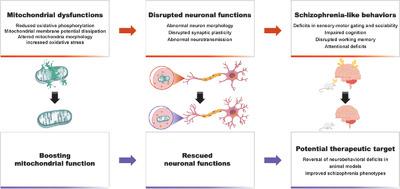Our official English website, www.x-mol.net, welcomes your
feedback! (Note: you will need to create a separate account there.)
Mitochondrial Dysfunction in Schizophrenia.
BioEssays ( IF 3.2 ) Pub Date : 2020-04-27 , DOI: 10.1002/bies.201900202 Peiyan Ni 1 , Sangmi Chung 2
BioEssays ( IF 3.2 ) Pub Date : 2020-04-27 , DOI: 10.1002/bies.201900202 Peiyan Ni 1 , Sangmi Chung 2
Affiliation

|
Schizophrenia (SCZ) is a severe neurodevelopmental disorder affecting 1% of populations worldwide with a grave disability and socioeconomic burden. Current antipsychotic medications are effective treatments for positive symptoms, but poorly address negative symptoms and cognitive symptoms, warranting the development of better treatment options. Further understanding of SCZ pathogenesis is critical in these endeavors. Accumulating evidence has pointed to the role of mitochondria and metabolic dysregulation in SCZ pathogenesis. This review critically summarizes recent studies associating a compromised mitochondrial function with people with SCZ, including postmortem studies, imaging studies, genetic studies, and induced pluripotent stem cell studies. This review also discusses animal models with mitochondrial dysfunction resulting in SCZ-relevant neurobehavioral abnormalities, as well as restoration of mitochondrial function as potential therapeutic targets. Further understanding of mitochondrial dysfunction in SCZ may open the door to develop novel therapeutic strategies that can address the symptoms that cannot be adequately addressed by current antipsychotics alone.
中文翻译:

精神分裂症中的线粒体功能障碍。
精神分裂症 (SCZ) 是一种严重的神经发育障碍,影响着全球 1% 的人口,具有严重的残疾和社会经济负担。目前的抗精神病药物是治疗阳性症状的有效方法,但不能很好地解决阴性症状和认知症状,需要开发更好的治疗方案。在这些努力中,进一步了解 SCZ 发病机制至关重要。越来越多的证据表明线粒体和代谢失调在 SCZ 发病机制中的作用。这篇综述批判性地总结了最近将受损的线粒体功能与 SCZ 患者联系起来的研究,包括尸检研究、成像研究、遗传研究和诱导多能干细胞研究。本综述还讨论了线粒体功能障碍导致 SCZ 相关神经行为异常的动物模型,以及作为潜在治疗靶点的线粒体功能恢复。进一步了解 SCZ 中的线粒体功能障碍可能为开发新的治疗策略打开大门,这些策略可以解决目前单独使用抗精神病药物无法充分解决的症状。
更新日期:2020-04-27
中文翻译:

精神分裂症中的线粒体功能障碍。
精神分裂症 (SCZ) 是一种严重的神经发育障碍,影响着全球 1% 的人口,具有严重的残疾和社会经济负担。目前的抗精神病药物是治疗阳性症状的有效方法,但不能很好地解决阴性症状和认知症状,需要开发更好的治疗方案。在这些努力中,进一步了解 SCZ 发病机制至关重要。越来越多的证据表明线粒体和代谢失调在 SCZ 发病机制中的作用。这篇综述批判性地总结了最近将受损的线粒体功能与 SCZ 患者联系起来的研究,包括尸检研究、成像研究、遗传研究和诱导多能干细胞研究。本综述还讨论了线粒体功能障碍导致 SCZ 相关神经行为异常的动物模型,以及作为潜在治疗靶点的线粒体功能恢复。进一步了解 SCZ 中的线粒体功能障碍可能为开发新的治疗策略打开大门,这些策略可以解决目前单独使用抗精神病药物无法充分解决的症状。











































 京公网安备 11010802027423号
京公网安备 11010802027423号